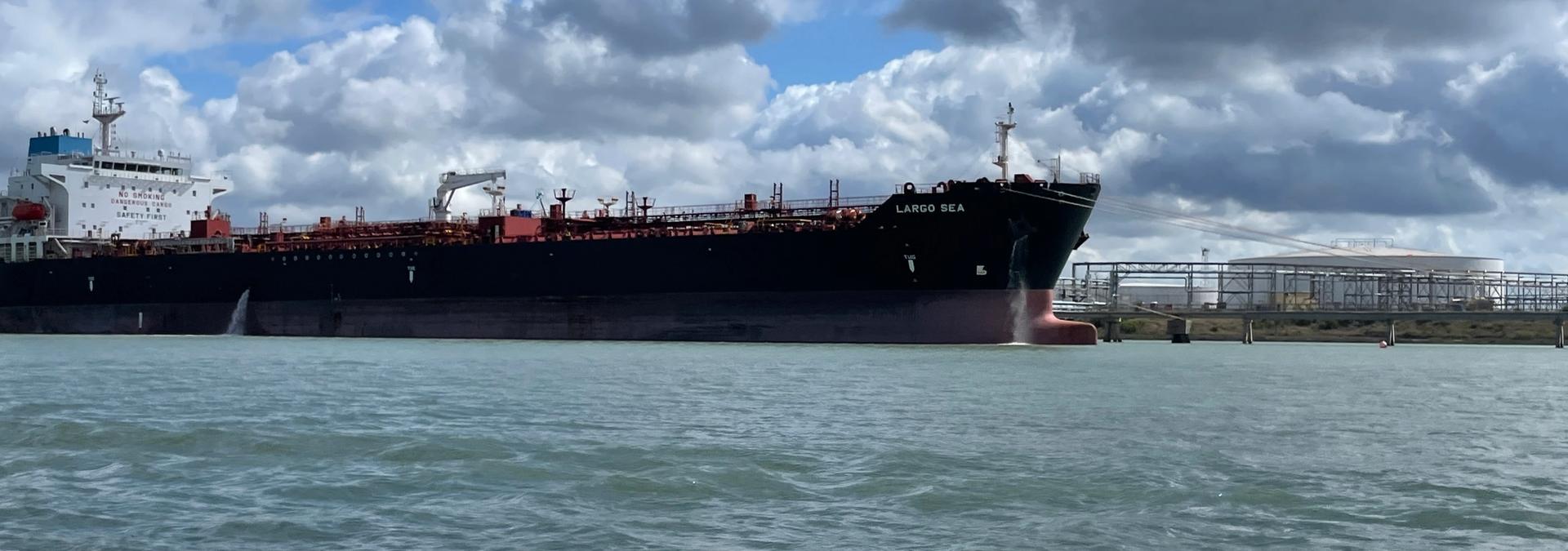
In the Coastal Bend, the causes of climate change are being permitted. Texas isn't considering the consequences.
At every stage of production, LNG releases methane, which is 85 times more potent a climate-destabilizing pollutant in the short term than carbon dioxide. Photo: Tori Young.
Marlene Plua knows the havoc climate disasters wreak. In 2017, Hurricane Harvey fed off warmed-up waters in the Gulf of Mexico, its rainfall increased by an estimated 38 percent, as it tore along the Texas coast up toward Houston.
Plua was working then as a legal aid lawyer in the Coastal Bend around Corpus Christi, helping families who struggled to get government aid after the storm destroyed their homes and livelihoods. Recovering has been exhausting ever since, Plua says, whether it was from Harvey or the February freeze last year. “It’s like rebuilding, rebuilding and then you get another disaster, and there’s no funds to recover,” she says. “A lot of families are still in that recovery process.”
Five years later, the blue waters and seagrass here are increasingly interrupted by a growing concentration of chemical plants, oil refineries and export terminals. From beach house backyards and school playgrounds, flare stacks are visible as they release tons of harmful chemicals and climate-destabilizing methane into the air. It’s where climate change begins and where the harms come right back. As liquified natural gas, or LNG, becomes more of a major global commodity and at least 20 corporations seek to increase production throughout the country, many of the same community members Plua worked with are wondering when anyone will start considering the consequences.
This year, scientists predict that conditions are ripe for another above-average hurricane season, with the potential for 6 to 10 hurricanes in the Gulf of Mexico and Atlantic Ocean. “We’re seeing the increase of these extreme weather events, and that is due to the fact that we have large emissions in the atmosphere,” Plua says. “I do contribute that to the fact that the LNG facilities and petrochemical facilities are building out. Ultimately, it comes down to the fact that we’re not prepared, and we need to reduce emissions. Communities are really sick and tired of this.”
In Nueces County, where Corpus Christi is located, the median income is just over $56,000 a year, lower than the state average; 17 percent of the county’s residents live below the poverty line. According to a recent report by Earthworks, nearly 70,000 people in the county live within a half mile of active wells and drilling facilities.
Corpus Christi Liquefaction is one of them. It’s an LNG processing plant that chills gas to subfreezing temperatures so it can be transported as a liquid fuel in tankers — and it can emit tens of thousands of pounds of methane when it suddenly starts up or shuts down. In 2016, Corpus Christi LNG became the first company to export it from the Texas coast. Since then, it’s been a big part of making the United States one of the world’s largest LNG exporters. In February 2022, the last month for which data is available, the plant exported 68 billion cubic feet of LNG to Asia and Europe. Last spring, the corporation received a federal permit to export even more gas to Europe during the war fought in Ukraine.
In a press release, the Department of Energy said it was still “focused on driving down methane emissions in the oil and gas sector.” But other community members like Elida Castillo are skeptical. At every stage of production, LNG releases methane, a particularly worrisome climate-changing pollutant: It’s 85 times more potent in the short term than carbon dioxide. It’s also hardly ever released in isolation: cancer-causing toxics and other hazardous pollutants are sure to follow, impacting nearby residents’ current health — and the future of their coastal communities.
A major hurricane hasn’t hit the Coastal Bend since Harvey, but people are feeling the consequences of climate change in other ways, says Castillo, who works with Chispa Texas. This summer, the Coastal Bend experienced a record-breaking heat wave, which extended nearly all across Texas, the most dangerous in communities that lack trees and shade and where homes with window units haven’t been able to be weatherized. “It feels like we’re living in an oven over here,” Castillo says.
The Inflation Reduction Act is expected to help, driving down carbon pollution 40 percent by the end of the decade and ensuring investments in historically ignored communities. But it will be up to states to make sure the $369 billion is spent equitably and strategically. And this is Texas, whose governor pretends not to understand climate change and whose state environmental agency commission chair said during a public meeting he didn’t “know what to do with the term ‘environmental racism.’”
Texas is one of 17 states lacking a comprehensive climate action plan. There are no state-specific requirements to report climate pollution — those are typically triggered only when a plant has to apply for permits for other pollutants the agency does limit. And the state environmental agency, the Texas Commission on Environmental Quality, has been reluctant to acknowledge the reality of climate pollution, even when it’s been required under law by the federal government.
In 2011, President Obama enacted the nation’s first regulations on carbon dioxide, through a provision of the Clean Air Act. The EPA required new limits and pollution cuts at large plants like the ones lining the Gulf Coast. “During the Obama administration,” says Thomas McGarity, a law professor at the University of Texas, “TCEQ simply said, ‘We’re not going to do it. We’re not going to consider greenhouse gas emissions.’”
“Texas was violating the law,” McGarity says. That led EPA to take over the greenhouse gas permits from the state, but under the Trump administration, EPA returned greenhouse gas permitting to Texas, which did end up complying with federal laws, even as it tried to weaken the few greenhouse gas regulations that exist. More recently, TCEQ protested when the Biden administration followed through on climate promises. Last year, EPA proposed enacting stronger methane standards from new and existing facilities.
Along with the Railroad Commission, the state agency that oversees oil and gas drilling, TCEQ wrote to EPA about a year ago to state that the oil and gas industry could be “significantly impaired” by the potential new rules, which the agencies, as they almost always do, called a “regulatory burden."
The Railroad Commission and TCEQ voiced support for exemptions for “low production well sites” which, though they don’t produce much oil and gas to sell off, are responsible for nearly half of all methane pollution from wells. Twenty-five percent or more of the warming we’re seeing is due to total methane emissions, multiple scientific studies have concluded. When asked whether TCEQ had reconsidered its support for these exemptions in the face of new research on methane pollution, an agency spokesperson responded: “No.”
“LNG has a big methane emission problem, and so far our state’s regulatory bodies have refused to fix the problem,” says Colin Leyden, the director of state and legislative affairs in Texas with Environmental Defense Fund. “Cutting methane is something we can do right now to help. Fortunately, EPA is working on a comprehensive set of leak prevention rules and the Inflation Reduction Act includes additional incentives to cut emissions.”
Meanwhile, as Texans reel from that warming and worry through hurricane season, the overall risks of a frenetic LNG buildout are becoming more apparent. The Freeport LNG explosion outside Houston in Brazoria County in June is just the latest in a long history of the industry’s permit violations and chemical incidents. But these corporations stand to profit once again at the expense of communities sacrificed and struggling with disinvestment, locking in decades more of the pollution that’s exacerbating weather events and harming the everyday health of those who live closest the hardest.
Castillo wishes that before TCEQ permits new facilities, they would send representatives to see the damage themselves. “We always hear from TCEQ that these industries have to flare, because they’re undergoing maintenance, so they don’t get fined,” Castillo says. “Texas likes to pride itself on, ‘Don’t Mess with Texas.’ Then they should stand up for communities and hold these industries accountable like they would a litterer.”
She knows that many of her neighbors won’t be able to afford to move out of harm’s way; some don’t want to, and others don’t believe they should have to leave the land their families have lived on for generations. “The thing that really concerns me is that this area is really becoming the industry's playground,” Castillo says. “It’s too beautiful and valuable to lose.”
Ahmed is an environmental reporter based in Dallas, Texas. Her work focusing on environmental justice has been published in the Texas Observer, Texas Monthly, Southerly and other outlets. You can find her on Twitter @amalahmed214.
STAY UP TO DATE
The quality of our newsletter is considered satisfactory and poses little or no risk.
SUBSCRIBE

